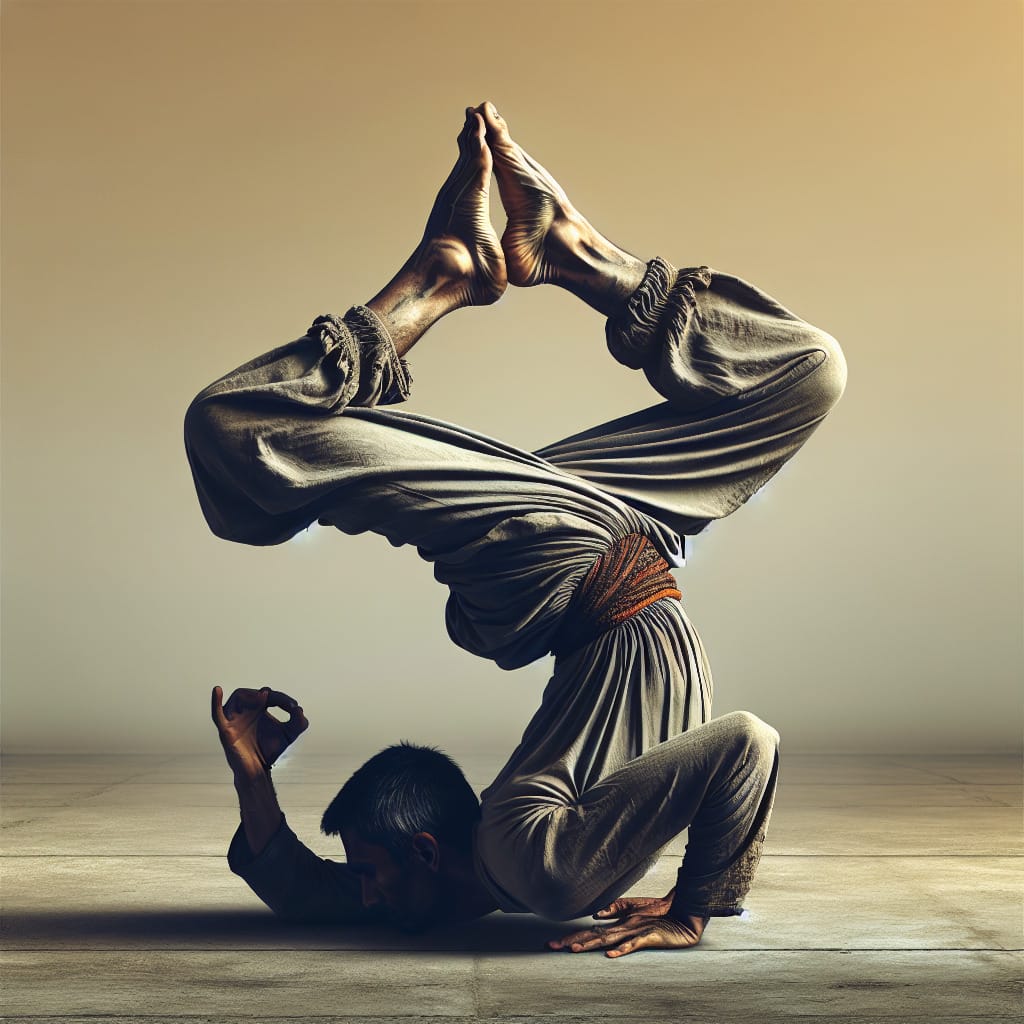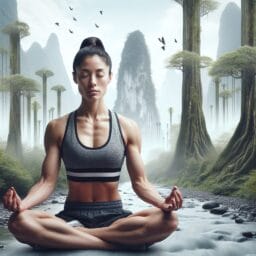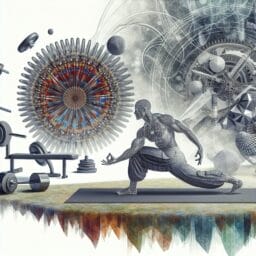
Unraveling the Benefits of the Garland Pose in Yoga
Table of Contents
- Introduction to the Garland Pose
- Understanding the Garland Pose
- Unveiling the Benefits of the Garland Pose
- Common Mistakes in Performing the Garland Pose
- Tips to Perfect the Garland Pose
- Conclusion: Embracing the Garland Pose
- Frequently Asked Questions
Introduction to the Garland Pose
The Garland Pose, known as Malasana in Sanskrit, is more than a deep squat – it’s a powerful tool for improved functional mobility and anatomical balance in any yoga sequence. Registered Yoga Instructors often emphasize this pose to athletes and casual yogis alike due to its unique ability to open the lower body. As you sink into the pose, your knees press outward while your torso leans slightly forward; This creates space around the ankles and groins, promoting flexibility in these often neglected joints. Athletes especially find benefit from this yoga pose as it aids in recovery after long periods of strenuous activity by easing tension and enhancing circulation. A wonderful aspect of this asana is its adaptability; whether practicing with feet wider or back against a wall to prevent falling backward, using folded blankets or blocks for lifted heels, or simply sitting on a block for support – there’s an approach suitable for all types of yoga practitioners. Not only does Garland Pose promote physical well-being but also nurtures spiritual growth through meditative aspects such as Anjali Mudra (prayer gesture) at heart center or using prayer beads during practice. Engaging in this transformative pose regularly can truly enhance both your yoga teaching tools and personal practice alike.

Understanding the Garland Pose
Garland pose, or Malasana, is a gamechanger in the world of yoga due to its remarkable benefits. Envisioned as far more than just a deep squat pose, this asana provides profound relief and increased functionality in your lower body by making space within your knee and ankle joints. As you delve into this pose, with knees pressing against your elbows from the inside and arms stretched forward, you develop an awareness of complex anatomy involved in yoga sequences. This intriguing position works wonders for athletes involved in long periods of strenuous activity by easing tension and enhancing circulation – it’s like having an on-call masseuse! The secret behind achieving the full expression of Garland Pose lies in maintaining a straight spine while your torso leans slightly forward. For beginners finding balance challenging, using props such as folded blankets under heels can provide support or practicing with feet wider apart can prevent falling backward. Further elevating its spiritual quotient, integration of Anjali Mudra at heart center during Garland Pose has been associated with unwinding the mind through meditative science; many even opt for guided meditation sessions or use prayer beads to enhance their experience. Whether you’re a registered Yoga instructor working on enriching your teaching tools or simply somebody who wishes to expand their practice – mastering Malasana can be a great boon.
Unveiling the Benefits of the Garland Pose
Immerse yourself in the profound transformation that the Garland pose or Malasana brings, allowing yoga to touch your life beyond just physical wellness. As you squat, with your feet wider apart and heels lifted on a folded blanket for support, this great pose engages the lower body intensely. The knees press against the elbows from inside while your arms extend forward – a full expression of functional mobility that strengthens lower body muscles and improves flexibility around hard-working knee and ankle joints. But Malasana’s benefits transcend anatomy yoga sequences; it aids digestion too – a boon for those dealing with gut issues. For athletes engaging in yoga after long periods of exertion, practicing this pose can efficiently ease muscular tension. By encouraging you to maintain a straight spine as you lean your torso forward and breathe deep, it also cultivates mindfulness – becoming an active part of one’s meditation guided regimen. Simultaneously merging Anjali Mudra at the heart center infuses spirituality into practice by enhancing focus and concentration levels, providing relief from stress as well.
| Benefit | Description |
|---|---|
| Physical wellness | Engages lower body muscles, improves flexibility around hard-working knee and ankle joints. |
| Digestion | Aids digestion, beneficial for those dealing with gut issues. |
| Relief of muscular tension | Can efficiently ease muscular tension especially for athletes practicing yoga after long periods of exertion. |
| Mindfulness | Cultivates mindfulness by encouraging to maintain a straight spine as you lean your torso forward and breathe deep. |
| Spirituality | Merging Anjali Mudra at the heart center enhances focus and concentration levels, providing relief from stress. |
Common Mistakes in Performing the Garland Pose
Despite its apparent simplicity, performing the Garland Pose or Malasana correctly can be a complex task for many yoga practitioners, often leading to common errors in posture and breathing. A frequent mistake is failing to keep the spine straight as you lean your torso forward; instead, many individuals tend to hunch their back. Ignoring the position of your feet is another prevalent misstep; maintaining feet wider than hip-width apart provides stability and prevents falling backwards. Awareness of breath also plays a key role in executing this pose effectively – remember to breathe deeply while settling into this deep squat pose. Furthermore, overstretching the ankles and groins can cause discomfort – it’s important to create space within these joints gradually rather than forcing them beyond their limit. As yoga teachers enrich their yoga teacher training foundations through online courses and podcasts, they equip themselves with essential tools that help students correct these oversights and reap full benefits from practicing Malasana. Whether you’re an athlete using yoga for recovery after long periods or someone seeking spiritual growth through meditation guided by Anjali Mudra at heart center – mastering this great pose requires patience, mindfulness, and proper understanding of anatomy yoga sequences.

Tips to Perfect the Garland Pose
Regular practice of Garland pose, or Malasana, reveals a surprising tapestry of physical and mental benefits. The lower body is awakened as knees press outward in this squat pose, creating space around the ankles and groins; an effective benefit yoga poses deliver for functional mobility. Athletes practicing yoga find respite from long periods of activity as it eases tension and improves circulation in these joints. In addition to fostering anatomical balance, Garland Pose also enhances spiritual growth – meditating on Anjali Mudra at heart center or using prayer beads can deepen one’s meditative science practice. Professional guidance from registered yoga instructors can aid practitioners in refining their posture with tools such as blocks for lifted heels or folded blankets under the feet for support. By making minor adjustments, like keeping your spine straight while leaning the torso forward during practice, you learn to expand your boundaries in mastering Malasana – ultimately enriching both your personal experience and teaching repertoire if you’re training to become a certified instructor.
Conclusion: Embracing the Garland Pose
In the world of yoga, the Garland Pose or Malasana brings a unique blend of physical and spiritual benefits. This deep squat pose strengthens lower body muscles while creating space around knee and ankle joints. An important addition to anatomy yoga sequences, it provides functional mobility, making it an excellent choice for athletes’ yoga routines after long periods of strenuous activity where easing tension is crucial. The impressive full expression of this pose comes when you maintain a straight spine as your torso leans forward; Remember, folded blankets can provide support for beginners struggling with balance. Registered Yoga instructors often emphasize the adoption of this power-packed pose in their teaching tools due to its extensive utility across various yoga types. Interestingly, Garland Pose extends its realm into spirituality too – practicing Anjali Mudra at heart center during Malasana can profoundly enhance meditation guided practice; some practitioners even prefer using prayer beads to deepen their meditative science experience. Whether you’re an experienced yogi or just starting your journey in this ancient practice, incorporating Garland Pose into your routine could be a transforming decision leading towards better physical health and mental tranquility.
Frequently Asked Questions
Q: What is the Garland Pose in yoga?
A: The Garland Pose, also known as Malasana, is a traditional yoga posture that involves a deep squat and has significant historical and traditional significance in yoga.
Q: What are the benefits of the Garland Pose?
A: The Garland Pose offers both physical and mental benefits. Physically, it aids digestion, improves lower body strength and enhances flexibility. Mentally, it can provide stress relief and improve focus and concentration.
Q: How should the Garland Pose be performed?
A: Detailed performance of Garland Pose involves specific physical alignment. While it’s advisable to get professional guidance, there are also step-by-step guides suitable for yoga practitioners at all levels to help achieve the Garland Pose correctly.
Q: Are there common mistakes to avoid while performing the Garland Pose?
A: Yes, common errors such as incorrect posture, overstretches, and improper breathing often occur while performing the Garland Pose. Proper guidance and attention to these areas can help avoid these mistakes.
Q: How can I perfect the Garland Pose?
A: Regular practice, use of yoga props, and professional guidance are all beneficial to mastering the Garland Pose.
Q: Should the Garland Pose be part of my regular yoga routine?
A: Incorporating the Garland Pose into your daily yoga routine can be highly beneficial due to the numerous physical and mental benefits this pose offers.



